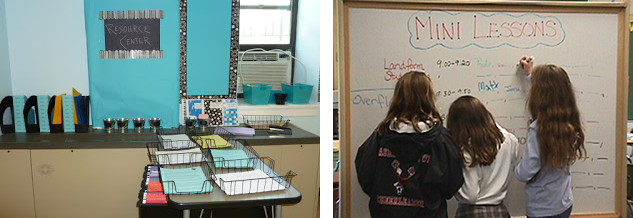Note: If you click on a link to the IDEportal and are a subscriber, log in; otherwise, click demo mode.
The goal of engagement should be “minds-on” passionate entanglement with the task at hand. In the Learner-Active, Technology-Infused Classroom, we achieve engagement through the use of real-world, problem-based tasks to launch a unit. Given a compelling, “non-Googleable” problem to solve, students have a “felt need” to grapple with and learn curricular content. These Authentic Learning Units (ALUs) generally run three to six weeks and include collaborative aspects for brainstorming and pushing higher-order thinking. Engagement is enhanced by students being able to take responsibility for their own learning, not being held back by the teacher or classmates. It is enhanced by students having a growth mindset geared toward learning. How does a Learner-Active, Technology-Infused Classroom teacher set students up for powerful engagement?
On the first day of school, a teacher who is unfamiliar with the students’ knowledge levels, work habits, and personalities cannot effectively create productive groupings. Additionally, there are many structures and strategies inherent in the Learner-Active, Technology-Infused Classroom that students must understand in order to take responsibility for their own learning. These include: reading a rubric to drive instruction, reading an activity list to select appropriate paths to success, scheduling time, using a folder for student-teacher communication, locating resources, effectively getting help when needed, and more.
Begin the year with a Priming Plan. Imagine students walking into class and immediately starting an activity with little overt direction from the teacher. Hearing from the teacher becomes one of several activities, as opposed to the dominant first order of the day. Students may walk in and be given a puzzle piece, a card with a question to answer, or some other means of identifying with others to form a small group. The group then follows a direction to retrieve a set of activities from a Resource Table, and the class has begun. After the first five or ten minutes, the activity schedule calls for the teacher to offer a short, introductory benchmark lesson to the whole class. Resuming with the activities, students may conduct a scavenger hunt of the room to identify various structures, such as the Help Board, Expert Board, small-group mini-lesson area and sign-up sheet, discourse center, and more. They may sign out a book or computer, fill out forms, take a learning-style inventory, complete content assessments. The Priming Plan is used to introduce the structures of the classroom and gather early assessment data in a student-centered manner.
 The Priming Plan should also be used to set students up for success by priming them for positivity and growth mindset. In Chapter 2 of his book Blink: The Power of Thinking Without Thinking, Malcolm Gladwell shares research on the phenomenon of “priming” — using auditory, visual, or tactile cues to nonconsciously shape behavior and thought. He refers to research by John Bargh in which he has college students walk down a hallway to a testing room, unscramble words into sentences, and walk out of the room and back down the hallway. Students who unscrambled words that related to old age, such as shuffleboard, bingo, Florida, and retirement, were primed with old age; they left the room walking more slowly than their peers who unscrambled words that did not prime them for old age.
The Priming Plan should also be used to set students up for success by priming them for positivity and growth mindset. In Chapter 2 of his book Blink: The Power of Thinking Without Thinking, Malcolm Gladwell shares research on the phenomenon of “priming” — using auditory, visual, or tactile cues to nonconsciously shape behavior and thought. He refers to research by John Bargh in which he has college students walk down a hallway to a testing room, unscramble words into sentences, and walk out of the room and back down the hallway. Students who unscrambled words that related to old age, such as shuffleboard, bingo, Florida, and retirement, were primed with old age; they left the room walking more slowly than their peers who unscrambled words that did not prime them for old age.
To prime students for success, you can fill the walls with images and quotes of famous people who exemplify the growth mindset. You can develop a Great Student Rubric that reflects a growth mindset, and deliberately use language that fosters a growth mindset. You can engage students in designing the room.
With the start of a new year, begin by developing a one- to two-week Priming Plan to prime students for success and to allow you to get to know your students. You’ll then launch your first Authentic Learning Unit a week or two into the school year, and students will be in a much better position to learn.

